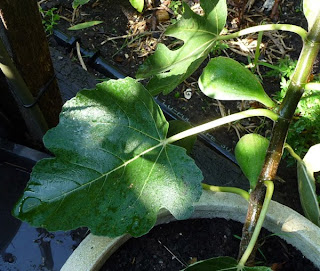A few images from the past week in my garden:
Eggplant 'Listada di Gandia'
Fireworks-shaped Parsley flower going to seed
I leave some of them to self-seed and then thin them out. The flowers attracts bees and other beneficial insects to the garden. And they're pretty!
Potatoes ready to dig out.
These were 'volunteers' from the compost. The leaves are from an ornamental Pistachio tree (Pistacia chinensis) growing in a big pot next to the veggies.
Pumpkin hammock made from an orange bag -
for support and possum protection
The pumpkins this year were also volunteers from the compost. The only ones that made were ones that were off the ground (I'll have to climb on top of the carport to get a few!). It was really disappointing to see the newly pollinated and fertilised (I saw the bees doing their job!) flowers start to fruit and then succumb to fungal rot and turn brown. This was in comparison to the volunteer potatoes and tomatoes that did just fine. It's all an experiment and the pumpkins just don't seem to be disease-resistant in my garden. Next planting season I will buy pumpkin seed and pull out the self-seeders.
Figs from 2009 cuttings
Did you know that figs flower on the inside of the fruit (they're kinda shy)? They are what's known as a 'multiple fruit'. Each fleshy bit on the inside of the fig is an individual fruit. Same with a pineapple. Each little segment is a single fruit (from a single fertilised ovary) and the whole pineapple is a multiple fruit. Very amazing!
Beans left for seed
I always collect some of the first crop of beans to dry out and then leave some on the vine towards the end of the season. That way I've got a good mix of early-flowering and late producing hardy plants the next season. I tried letting some of the beans climb up the corn stalks this summer...apparently a permaculture technique. It looks pretty but the corn really blocked the sun from the beans and they weren't very productive in this spot. For anyone who read Neil Stephenson's recent sci-fi book Anathem, it reminded me of the 'tangle' that each monk grew for food production!
Asparagus starting to die back
Asparagus is a perennial in the lily family. These one to one-and-a-half metre tall plants are what happens to the spears that aren't cut to eat. They photosynthisize all summer, the female plants flower, and they store food and multiply underground. This year's plants will die and in the spring new plants will appear as little asparagus spears. I'll cut this asparagus down to the ground when it all goes yellow in few weeks and build up the beds with compost and blood-and-bone so they will have good nitrogen-rich soil in the spring.
Artichokes re-sprouting, Amaranth in leaf and Parsley setting seed
It's all a cyle of birth, life, death and re-birth in the garden. There's always something going on!
Next time...we go to Jamaica in the garden! Ya mon...









Had no idea your garden was so extensive. How creative, hanging your pumpkins. Just don't fall off the roof when retrieving them. That eggplant is beautiful and bet it's delicious also. I'm having a problem also with blossom rot on my butternut and buttercup squash when they get to be about one inch long. Have read that it's lack of calcium, but don't think so. We've had alot of wind that has really been drying up the soil. Maybe I'm overwatering. Am off to read more of your Blog. It's really creative, interesting and informative and wonderful photos---
ReplyDelete